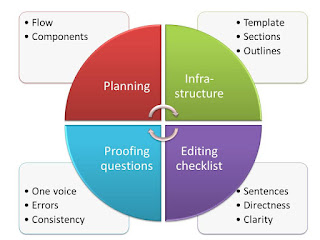But all too often,writers leave too little time for the actual report-writing. Instead of a careful, considered approach, we get a ‘last minute rush’.
There are four 'helpers' for our writing: planning, infrastructure, editing checklist and proofing questions.
Planning
When we tell a story, we need to ensure there is a logical flow. Some people will think about the major parts of the story that they need to tell which includes the players, the context, the plot, the conflict, and the resolution, denouement or ending. Some people will achieve that logical flow by having a ‘heading hierarchy’ which includes chapter headings, section headings, sub-section headings.
Regardless of how we want to approach it, planning where we are going, and what we need to say on the way will mean our communication is clear.
Infrastructure
How we can help to avoid that is to develop our report 'infrastructure' early. The infrastructure is the formal aspects of a report such as a title page; abstract; acknowledgements; contents, figures & tables; (preface or foreword if appropriate); section headings and appendices; production of diagrams, figures, tables and theming of overall design.
Report infrastructure which can be written or outlined well in advance includes our:
- Template including Word auto table of contents, page numbering, Word referencing, section headings including bibliography & appendices (if needed)
- Introduction;
- Literature review;
- Methodology including description of the methods, statement of objectives, outline of the theoretical or evaluative framework;
- Findings space with an outline of possible direction
- Discussion space with ideas on what might turn up here
- Conclusions.
Having all those areas outlined in a template, ready to pour the rest of our work into, helps us put the rest of our report together much more quickly.
Editing Checklist
- Have we eliminated unnecessary words and phrases? Checked that we aren't saying things the same way twice (eg “halfway through the centre of the middle”)?
- Have we written directly and simply, using short words; and avoid having 'inflated' verbal diahorrea?
- Are our sentences direct and not run on? Do we have balance between our long and short sentences? Do we have balance between simple and complex sentences?
- Have we checked our paragraphs order? Can we re-order to build a clearer argument?
- Do our sentences make logical, clear sense?
- Are our references treated as sub-clauses?
- Is our vocabulary appropriate for our audience and as clear and precise as possible?
- Is our language consistent throughout, such as nouns, pronouns; adjectives (academic writing tends to be formal, avoiding informal adjectives eg ‘nice’ and ‘fantastic’)?
- Have we used synonyms where possible, to avoid repetition which will tire and eventually annoy the reader?
- Have we avoided sweeping statements? Have we used adverbs in order to be precise? (academic writing tends to avoid over-generalisations and often uses adverbs such as ‘often, usually, rarely etc. to express caution about the statements being made)
- Have we set out our references in an appropriate format for our reader to understand?
- Have we considered our audience – will they need a glossary for any technical terms?
- Have we acknowledged all the people – funders, contributors and participants – who need to be mentioned?
- Have we put material that is too detailed or cumbersome to be included in the body of the report, but that we want to be available to the reader, in an appendix? (that includes things that are simply a 'nice to have', or are hard to get).
Proofing questions
- Have we used correct tenses in the report? (NB: the present tense is usually used to mention opinions and ideas from other research)
- Have we proofread the entire report to make sure there are no typographical – spelling, grammar, usage – errors?
- Have we checked for common errors – like NCTC instead of NTCC? Have we done a find and replace all before we have proofed?
- Have we double-checked that all graphs and tables have titles, sources and labels; they are in our list of figures; and that all have a map back to the source (reference)?
- Have we been consistent with naming of all key components, capitalising, section numbering (or not), page number presentation; appendices names and/or numbering; citation of graphics and illustrations?
Lastly, we should double-check there are no glitches with our template where our spell-check doesn’t work, or where the page numbering falls off. Learning how to turn on paragraph marks and other non-printing characters in Word so we can repair these errors (Customise Quick Access Bar | More Commands… | Choose Commands from “All Commands” | Show all) will save us MUCH angst, long-term!
Hope that helps!
Sam
References:
- University of Warwick (2006). Academic Writing Checklist. Retrieved 29 August 2014 from http://www2.warwick.ac.uk/fac/soc/al/learning_english/leap/writing/conclusions/academic_writing_checklist.pdf
- Veal, A. J. (2005). Business Research Methods – A Managerial Approach (2nd ed). Australia: Pearson Education Australia (Chapters 12-15)


No comments :
Post a Comment
Thanks for your feedback. The elves will post it shortly.